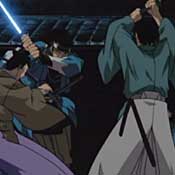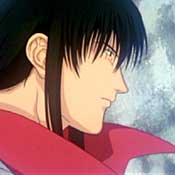by Owen Thomas
|
Ironically, Ieyasu Tokugawa, the Shôgun (military ruler) who issued the edict prohibiting movement between the classes, had himself been born to a lower class and wound up ruling Japan and founding a Shôgunate dynasty. Having risen above his inherited station to conquer Japan he was understandably inclined to erect obstacles to any would-be imitators. Only during episodes of peace were the samurai truly a hereditary class. "Samurai X" is set during the times of bloody war to remove the Shôgunate and restore power to the Imperial throne (which occured in 1867). Reality trumps theory every time. By any realistic definition, Kenshin is clearly a samurai. "If the cowboy symbolizes the American ethos, then the samurai warrior surely symbolizes the ethos of Japan," writes Frederik Schodt in "Manga Manga," a comprehensive history of the manga art form. Semantically a cowboy is a cattle-herder, but in literature and imagination the cowboy is much more. American film and fiction has often idealized, romanticized, and mythologized the cowboy; painting them as self-reliant, fiercely individual, innately virtuous, pioneers - rarely acknowledging how many illiterate, syphilitic, racist, toothless horse rustlers and murderers populated the American frontier. Likewise, Americans have come to view samurai in Japanese fiction as noble, serene, stoic warrior/philosopher paragons of Budo, regardless of how many thieving, impoverished, assassins and rogues fill the history books. Such is ever the way when a culture transmutes human beings into symbols.
When the Shôgunate consolidated power, closed off the country, and ushered in the relative peace of the Edo period, starting in 1603, Tokugawa Ieyasu essentially rendered tens of thousands of samurai unemployed. He had ordered all the provincial daimyô to disband their armies, which left thousands of ronin (masterless samurai) roaming the country. Many worked as bodyguards or became martial arts instructors. Thousands more survived as bandits, mercenaries, assassins and beggars. To confront the problems many lawless samurai caused, Ieyasu issued thirteen principles for the life of a warrior in peace and encouraged samurai to pursue education with vigor equal to their study of the martial arts. Those principles, combined with the tradition of the way of the horse and arrow and Zen philosophy, gave rise to the Bushido (way of the warrior) code. The Bushido code (which Soko Yamaga, 1622-1685, defined and advocated) was regarded as the ideal to which all warriors should aspire. The code emphasized the absolute importance of duty (giri), discipline, self-sacrifice and excellence. Bushido required a complete willingness to die rather than fail one of those principles. As with every code of ethics from that of Hammurabai to the uniform code of military justice, Bushido embodied a group's ideals, though human behaviour always struggles to rise above its basest instincts. The spirit of Bushido however spread beyond the samurai. The Bushido code gave rise to Budo, and the ways of the warrior came to be regarded as fine arts. During the eighteenth and early nineteenth centuries families of the samurai class, free from the burden of fighting wars, emerged as leaders in statesmanship, arts and culture. The code requiring their absolute willingness to die proved much easier to live by during times when relatively few samurai actually did. Well after the samurai class had been abolished by edict in 1876 the ideals of budo had permeated society from the top down. Today the term yamato damashii (spirit of Japan) refers to the principles, primarily duty, discipline, self-sacrifice and excellence taught to young Japanese men in walks of life from sports to business, politics to publishing. Samurai from history and fiction are often portrayed as the embodiments of these principles, and the figure of the samurai remains one of Japan's most pervasive archetypes. However, storytellers tend to focus on the romanticized violence associated with the samurai. "They prefer to depict the brawls and the debauches of � picturesque if disorderly characters," notes Sansom. Nonetheless, the popular, romanticized cowboy characters blur over time while the less ideal, more ambiguous, more believably human characters in John Ford's "The Searchers," or Clint Eastwood's "Unforgiven," endure as iconoclastic counter-archetypes. So too, despite the volume of idealized portrayals, many of the most vital and vivid portrayals of samurai are those such as Tochiro Mifune's Kikuchiyo in Akira Kurosawa's "Seven Samurai," and Itto Ogami of Kazuo Koihe and Goseki Kojima's seminal "Lone Wolf and Cub," that offer characters who have ideals without being ideal. Rurouni Kenshin belongs to this distinguished fictive lineage, which dates back to one of the most legendary samurai of all. Shinmen Mushashi No Kami Fujiwara No Genshin, better known as Musashi Miyamoto (1584-1645) earned a legend in his own time as one of the greatest swordsman and duelist of his age, and authored the "Gorin No Sho (Book of Five Rings)" a text on strategy and spirit that is still widely read around the world today. His life was the basis of a novel "Musashi" by Eiji Yoshikawa. Originally published in serial from 1935-37, it has sold more than 125 million copies around the world and in 1960 made Eiji the first popular fiction writer to receive the Order of Culture from the Japanese government (a lifetime achievement award for significant contributions to Japanese culture). Musashi has also been the basis for feature films including the "Samurai" trilogy by Hiroshi Inagaki (known as Japan's "Gone with the Wind"), uncounted other books, and a slew of video game characters (including Haohmaru in "Samurai Shodown"). He is known to this day as Kinsei (Sword Saint) amongst Kendo practitioners, and a national museum and monument are dedicated to him. In his later years Musashi turned the principles of the way of the sword into an approach to Zen, art, and life. He became a renowned painter and poet, founded a specific style of sword-making, and became the ubiquitous example of what all warriors should strive to become by following Ieyasu's principles and studying Budo. In many fictional portrayals the most ideal, romantic image of the samurai has been sanctified with Musashi's name. Despite his iconic status, the historical Musashi in his youth was unlike the idealized image of a samurai in many of the same ways as Kenshin. Unlike most samurai, Musashi never shaved his head to leave only his topknot. He was famous for wearing a full head of long, unkempt, hair - as Kenshin does. Musashi lost both of his parents while still a young child - as has the orphan Kenshin. When Ieyasu Tokugawa ordered all the provincial lords to disband their armies, Musashi became a wanderer, as does Kenshin in the T.V. show, "Rurouni Kenshin."
The OAV story itself borrows and expands upon elements of Musashi's life. In his wanderings Musashi adopted a son, Iori, whose family had died. Musashi took Iori to the mountains for three years where Musashi dedicated himself to mastering the way of the sword while Iori watched. Kenshin is adopted by the traveling swordsman Hiko and taken to the mountains where he lives alone with his master for several years, dedicated to learning the way of the sword. And of course Kenshin becomes well nigh invincible at his craft - as Musashi was. The details of the Musashi legend that have been grafted into Kenshin's life (which, except for the hair-do, are untrue of Kawakami Genzai) can no more be accidental than a baby-faced gunfighter called 'kid' in American fiction could be. Whatever the less glamorous details of his real life, Musashi endures in legend today as one of the greatest swordsman in history. By evoking his legend in the story of Kenshin's life, Kenshin's creators effectively paint him in that same light. However, although deliberately designed to evoke Musashi, Kenshin, for whom the way of the sword leads to misery and self-loathing, belongs to a much newer character archetype in samurai fiction: the antihero. |


